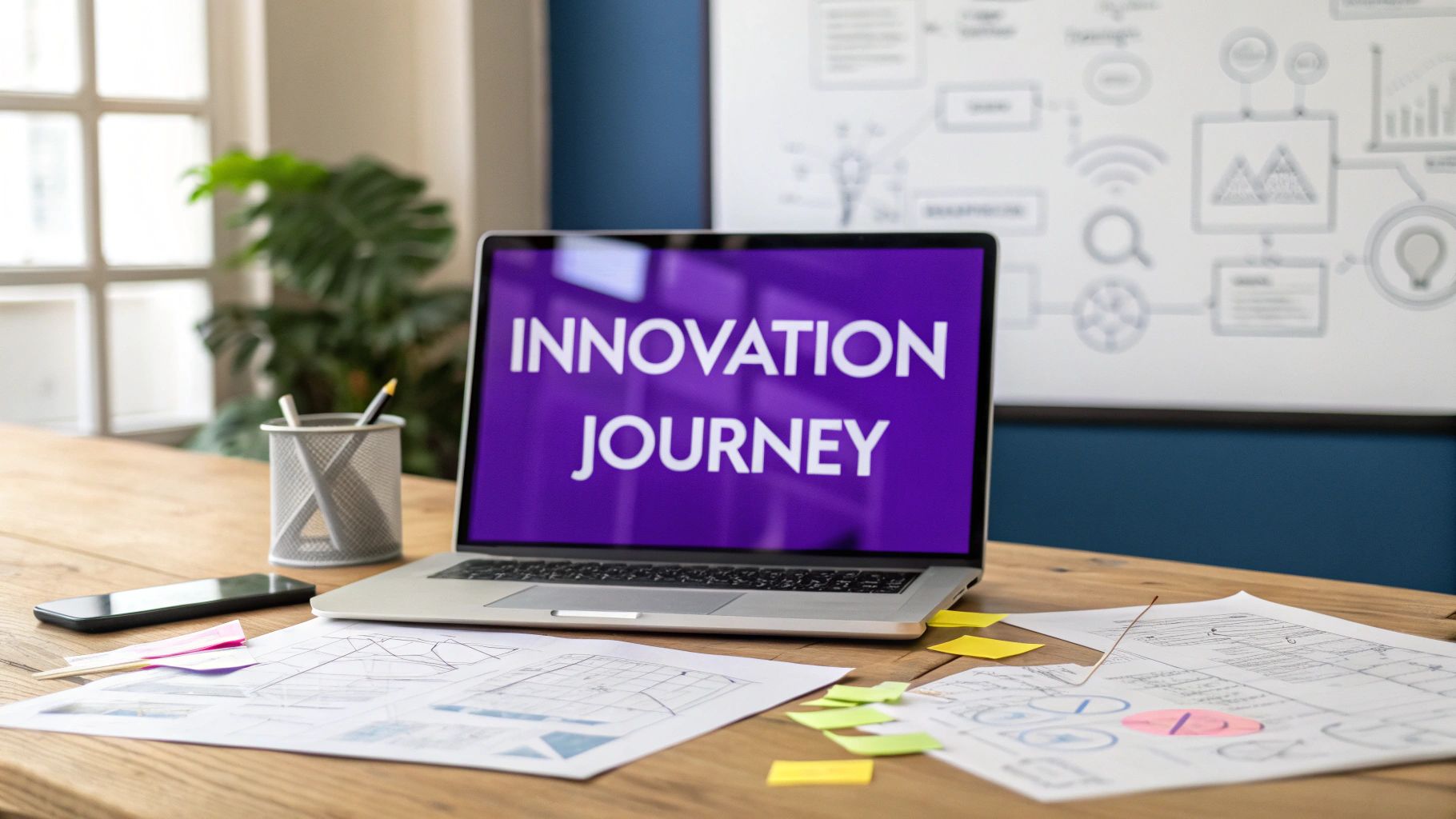Innovation isn’t some mystical flash of genius that strikes out of the blue. It’s a process—a disciplined, repeatable system that any team can learn and master. Too often, we talk about innovation in vague, abstract terms, but that doesn't help when you're on the ground trying to turn a good idea into a great product.
This guide cuts through the noise. We're laying out a clear, actionable roadmap that breaks down the entire journey, from that first spark of an idea to a full-blown market launch. It’s specifically designed for modern teams, especially those navigating the challenges of remote work. The goal here is simple: stop just talking about ideas and start building a system that delivers real, measurable results.
The Innovation Funnel: From Many Ideas to One Winner
A great way to visualize this journey is through the "innovation funnel." Think of it as a filter. At the wide top, you pour in a ton of raw ideas—the good, the bad, and the downright weird. As these ideas travel down the funnel, they go through a series of checks and refinements.
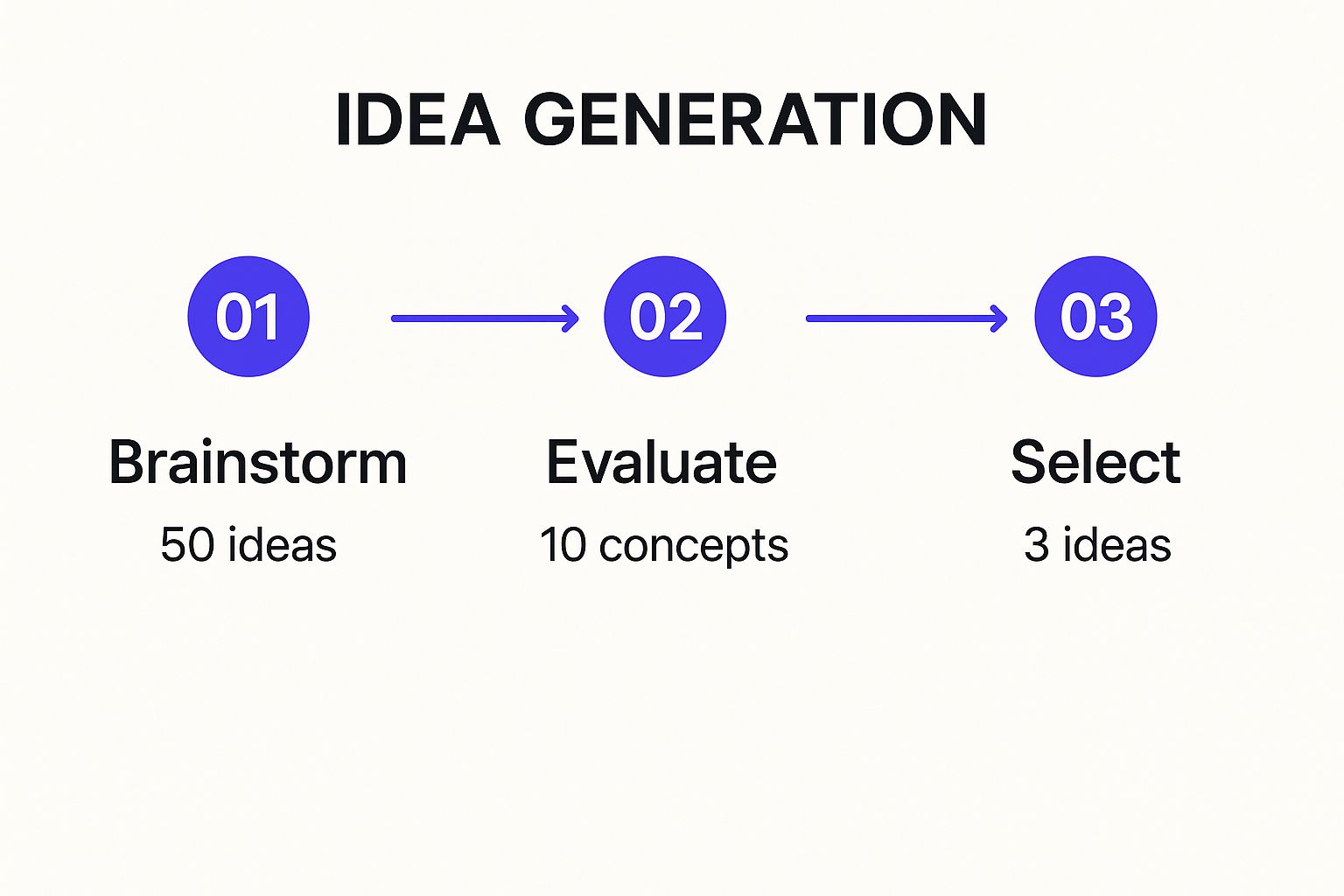
Only the strongest, most viable concepts make it out the narrow end. This image shows perfectly that innovation is a numbers game at the start, but it’s all about quality in the end. It's not about having one perfect idea; it's about having a system to find the best one.
For this to work, especially with a distributed team, you need the right tools. A platform like Bulby is built for this, providing a shared space to capture, discuss, and refine ideas. It brings structure to the creative chaos, ensuring great thoughts don't get lost in a sea of chat messages or emails.
The journey from a raw concept to a polished final product is complex and multi-layered. To get a sense of what a full-scale development cycle looks like in a specific field, you can check out a comprehensive guide to the mobile app development process.
What Are the Core Stages of Innovation?
While the specifics might change, the innovation journey generally follows a few distinct, interconnected phases. Each stage builds on the one before it, making sure you’re always focusing your energy on the ideas with the most promise.
- Idea Generation & Validation: This is where it all begins. You're not just brainstorming random stuff; you're actively looking for real problems to solve and then generating a wide range of potential solutions.
- Prototyping & Testing: Here, you start making your best ideas tangible. You build simple, low-cost models or mockups to get them in front of real users and gather honest feedback. Fast.
- Implementation & Development: Once an idea has been validated and refined through testing, it's time to build the real thing. This is where the refined prototype is turned into a market-ready product or service.
- Commercialization: The final step is the launch. You introduce your innovation to the world and get it into the hands of your customers.
To help you keep these stages straight, here’s a quick overview of what each one is all about.
The Core Innovation Stages at a Glance
| Stage | Primary Goal | Key Activities |
|---|---|---|
| Idea Generation | Find and capture a high volume of potential solutions to real problems. | Brainstorming, market research, customer interviews, trend analysis. |
| Validation | Filter the raw ideas to find the ones with the most potential. | Idea scoring, peer review, feasibility checks, concept testing. |
| Prototyping | Create a tangible, testable version of the idea to gather user feedback. | Wireframing, building mockups, developing a minimum viable product (MVP). |
| Implementation | Build the full-featured, market-ready product or service. | Engineering, design, quality assurance, project management. |
| Commercialization | Successfully launch the innovation and drive adoption. | Marketing campaigns, sales strategy, customer onboarding, gathering feedback. |
Think of these stages not as a rigid checklist, but as a flexible framework. The real magic happens when you move through them thoughtfully, learning and adapting along the way.
By following a structured process, you take the guesswork out of innovation. It stops being a game of chance and becomes a strategic capability that can consistently drive growth and keep you one step ahead of the competition.
Finding and Validating Your Next Big Idea
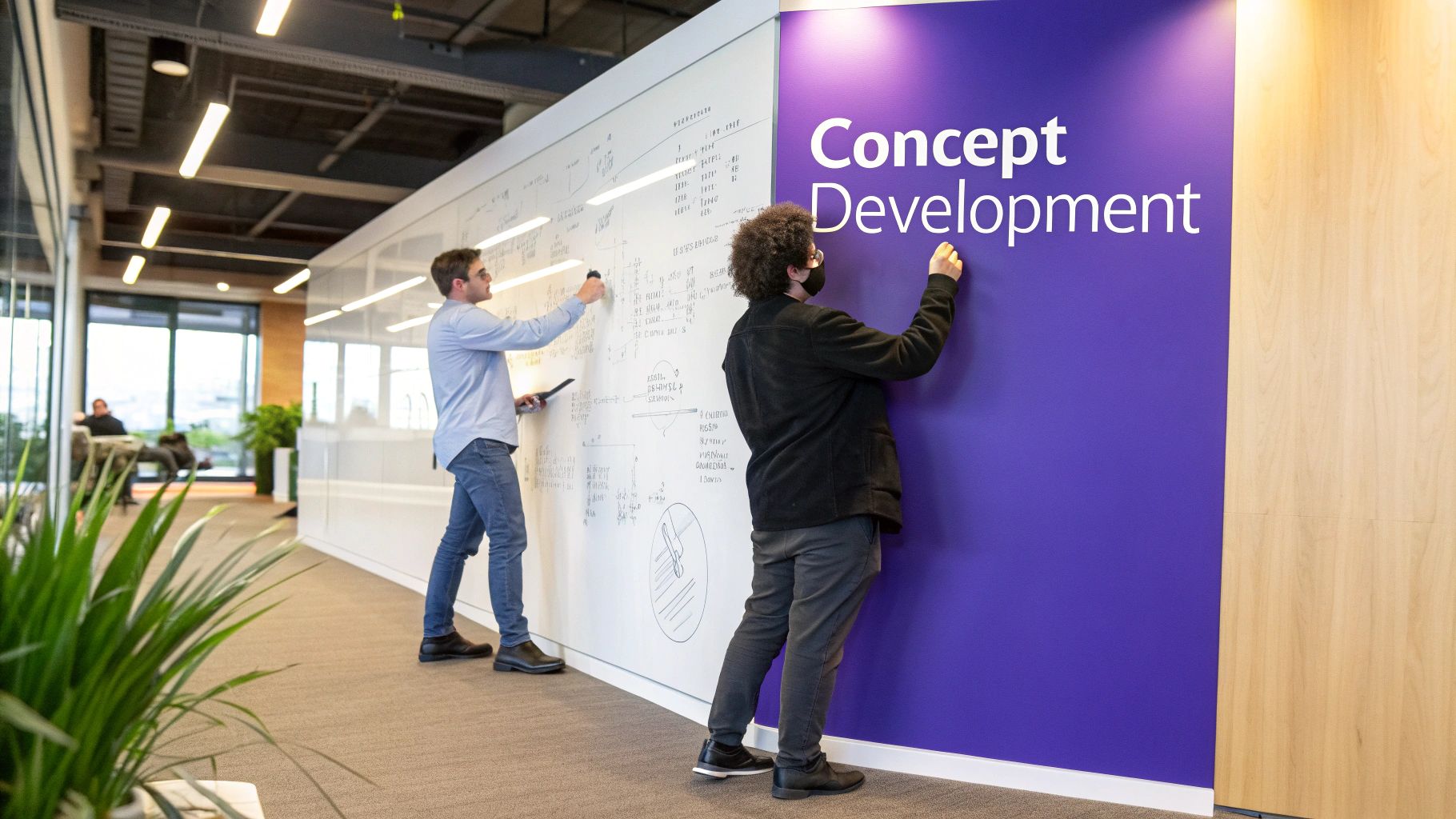
Every great product started as just one of many ideas. The real magic isn't in having a "eureka!" moment, but in creating a system where those flashes of brilliance can be captured, shared, and actually go somewhere.
For remote teams, this is even more critical. Ideas can easily get lost in a sea of Slack messages, forgotten in a random Google Doc, or never even mentioned because the right moment never came up. This is where a dedicated tool like Bulby comes in. It gives everyone a central, transparent place to drop an idea, big or small, and know it won’t just vanish into the ether.
From a Trickle to a Flood of Ideas
Right now, don't worry about finding the perfect idea. The goal is to get as many concepts on the table as possible. Think of it as building a huge pile of clay before you start sculpting. Just asking your team to "be innovative" rarely works. You need to be more intentional.
Here are a few ways I’ve seen teams kickstart this process, even when they're miles apart:
- Try an Asynchronous Brainstorm: Instead of another video call, post a specific challenge or question in Bulby. Give everyone 48 hours to add their thoughts. This is a game-changer for introverts and teammates in different time zones who need time to think things through.
- Host a "Problem-First" Workshop: Flip the script. Dedicate a virtual session to only discussing and defining a customer pain point in excruciating detail. The best solutions almost always emerge from a deep, shared understanding of the problem itself.
- Open the Floodgates: Invite people from sales, customer support, and marketing to join the conversation. They’re on the front lines every day, hearing directly from customers about their frustrations and wishes. Their insights are pure gold.
This early ideation phase is where you separate real opportunities from your own assumptions. Getting it right saves you from pouring time and money into building something nobody actually wants.
Sifting for Gold: How to Spot the Winners
Okay, so you have a huge list of raw ideas. Now what? It's time to start filtering, but not based on gut feelings. We need a simple, repeatable process to figure out which concepts are worth a closer look.
Start by running each promising idea through a quick sanity check. Ask yourself:
- The "Who Cares?" Test: Does this solve a real, nagging problem for a specific group of people?
- The "Why Us?" Test: Does this actually fit with our company’s bigger goals? Or is it a shiny distraction?
- The "Can We?" Test: Honestly, do we have the skills, resources, and tech to pull this off right now?
This isn't about killing creativity; it's about focusing it. Globally, the biggest innovators spent over $1.2 trillion on R&D in 2023, and a huge chunk of that—up to 20%—went into this exact kind of early-stage exploration. There’s a reason only about 10% of initial ideas ever make it to the prototype stage. Rigorous filtering works. You can see more data on these trends in the full report from WIPO.
Of course, the ultimate test is getting an idea in front of real people. For a deep dive into that, check out our guide on https://www.remotesparks.com/how-to-conduct-user-research/. And as soon as you feel like you've landed on something special, it's never too early to think about protecting it. Learning how to protect your business idea can save you a world of headaches down the road.
From Concept to Tangible Prototype
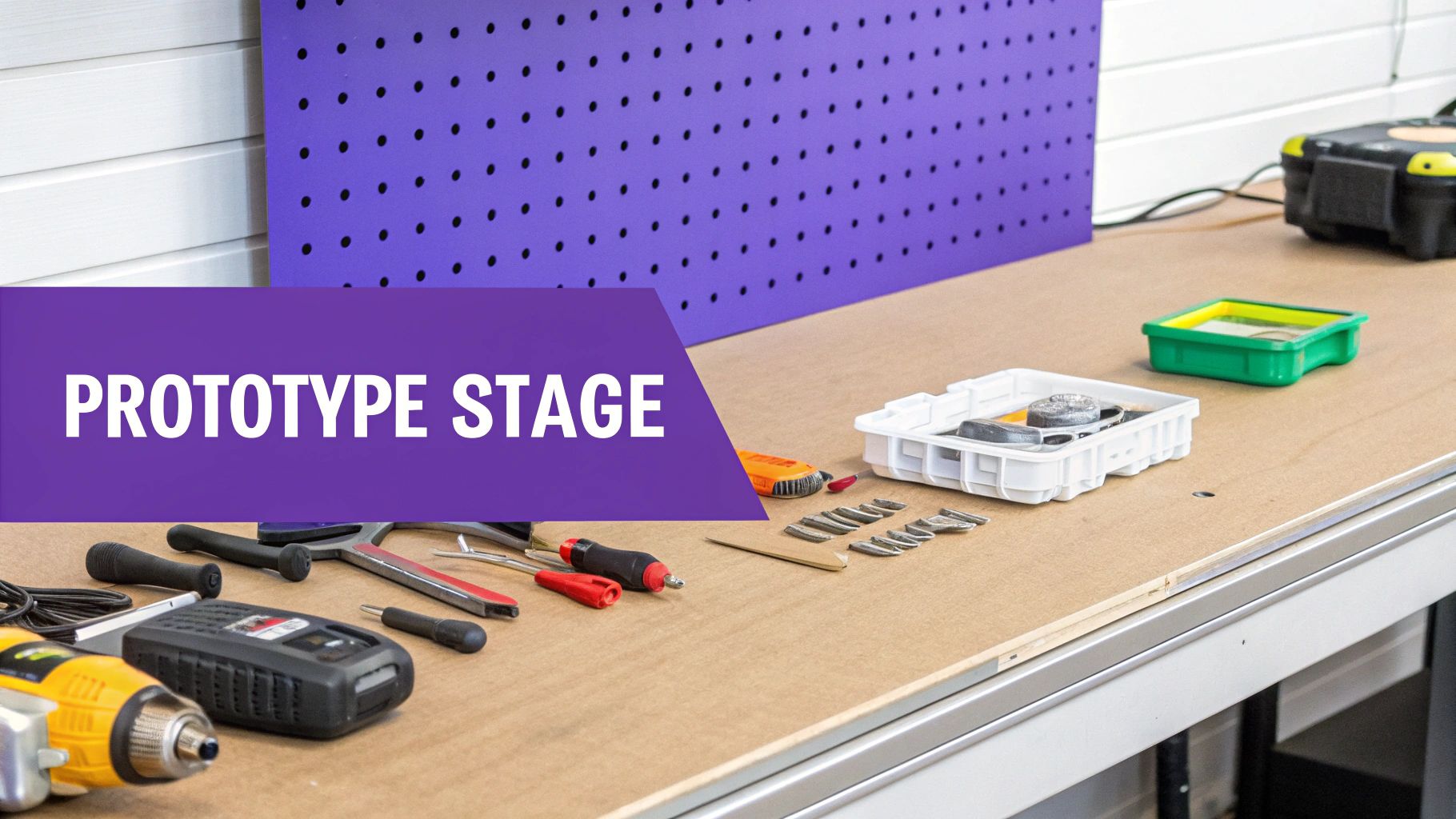
An idea is just a thought until you can see it, touch it, and play with it. That's what prototyping is all about—turning a validated concept into something real. The goal here isn't perfection. It's about learning as much as you can, as quickly and cheaply as possible.
This is often the most exciting part of the whole process. You finally get to see your team's vision take shape. For remote teams, this used to be a real headache, but collaborative tools have completely changed the game. Platforms like Figma or Miro give everyone a shared digital canvas, letting the team watch the prototype evolve, drop in feedback, and tweak things in real-time.
Choosing Your Prototyping Approach
There’s no magic bullet for prototyping. The right approach depends entirely on what you’re trying to figure out. Are you just testing the basic flow of a new app? Or do you need to see how people react to the look and feel of a physical object?
- Low-Fidelity (Lo-Fi) Prototypes: Think paper sketches, simple wireframes, or even a storyboard. They’re incredibly fast and cheap, which makes them perfect for testing the big-picture concepts without getting lost in the weeds of visual design.
- High-Fidelity (Hi-Fi) Prototypes: These are much closer to the real deal. They’re interactive, visually polished digital mockups that look and feel like a finished product. You'll want to use these when you're ready to test specific user interactions or fine-tune the overall experience.
My advice? Always start with lo-fi to make sure your core idea holds water. As you get more confident, you can gradually dial up the fidelity. If you want to explore the options, our guide on rapid prototyping methods is a great place to start.
The Build-Test-Learn Loop
Building the prototype is just step one. The real magic happens when you put it in front of actual users and just watch. This is the heart of the build-test-learn loop, a simple cycle that’s the secret sauce behind almost every successful innovation.
The purpose of a prototype isn't to impress anyone—it's to learn. Every bit of feedback, good or bad, is gold. It’s a clue that gets you closer to a successful product. Don't get defensive about your creation; let users break it so you can build it back even better.
Set up some casual testing sessions. Seriously, even a 15-minute video call with a potential user can uncover game-changing insights. Give them a simple task to complete with your prototype, and then just observe. The hardest part is resisting the urge to jump in and help them.
Key Questions to Answer During Testing
- Do they get it? Can they figure out what your product does without you explaining it?
- Can they use it? Where do they get stuck, confused, or frustrated?
- Do they even want it? After trying it, do they seem genuinely interested or excited about it?
Collect all that feedback, pinpoint the biggest problems, and use those insights to make your prototype better. Then you do it all over again. This loop ensures you’re not just building a product—you're building the right product, one that’s been shaped by real user needs from the very beginning.
Turning Your Prototype into a Real Product
So, you’ve put your prototype through the wringer. You've tested it, tweaked it, and refined it based on real feedback. It's no longer just a cool concept—it's a validated solution. Now the real work starts. This is the implementation phase, where your tested idea finally grows up and becomes a real product ready for the market. It’s less about wild creativity and more about disciplined, focused execution.
This stage absolutely requires a clear roadmap. Think of it as the construction blueprint for your entire project. It needs to detail every major feature, establish timelines that are actually achievable, and spell out who owns what. For a remote team, this document is everything. It becomes your single source of truth, making sure everyone is pulling in the same direction, no matter where they are.
Building with Speed and Quality
When it comes to the actual development, agile methodologies are a game-changer. Forget trying to build the whole thing in one giant, overwhelming push. Instead, you break down the work into small, digestible cycles called “sprints.” Each sprint usually lasts about two weeks and has a single goal: deliver one specific, usable piece of the product.
This approach is a perfect fit for remote teams, especially when you use a central hub like Bulby to keep everyone synced up on progress. It maintains momentum and, more importantly, lets you pivot without capsizing the whole ship. Run into a technical snag? Get some surprising customer feedback? No problem. You can adjust your plan in the very next sprint instead of throwing months of work off track. This iterative cycle is a cornerstone of the modern steps in the innovation process.
Don't fall into the trap of aiming for a flawless "big bang" launch. That's a recipe for delays and wasted resources. Get a solid foundation built first. Your best friend here is the Minimum Viable Product (MVP). It’s designed to get you to market fast so you can learn from real users, not build features no one asked for.
An MVP isn't just a half-baked, buggy version of your product. It’s the simplest, leanest version that solves one core problem for your ideal customer. There are some fantastic minimum viable product examples out there that prove how this lean-and-mean approach helped launch some of the biggest names in tech.
From Launch to Lasting Growth
Getting your product built and out the door is a massive accomplishment, but don't pop the champagne just yet. That isn't the finish line. As you shift from building to launching, your entire focus has to pivot to your go-to-market strategy. After all, how will anyone find out about the incredible thing you just built?
This next chapter involves a few critical moves:
- Nail Your Messaging: If a customer could only remember one thing about your product, what would it be? That’s your core message.
- Pick Your Channels: How will you reach people? Will you focus on content marketing, hit social media hard, run paid ads, or build a direct sales team?
- Prepare for Customers: Make sure your support and operations teams are truly ready for new users from the moment you launch. Nothing kills momentum faster than a poor day-one experience.
Successfully getting your innovation to market and scaling it is about so much more than just shipping code. It’s about building a durable, sustainable operation that can handle growth. By mapping out a detailed plan, building efficiently with agile methods, and thinking through your market entry from the start, you give your promising prototype a real shot at becoming a lasting success.
Bringing Your Innovation to Market
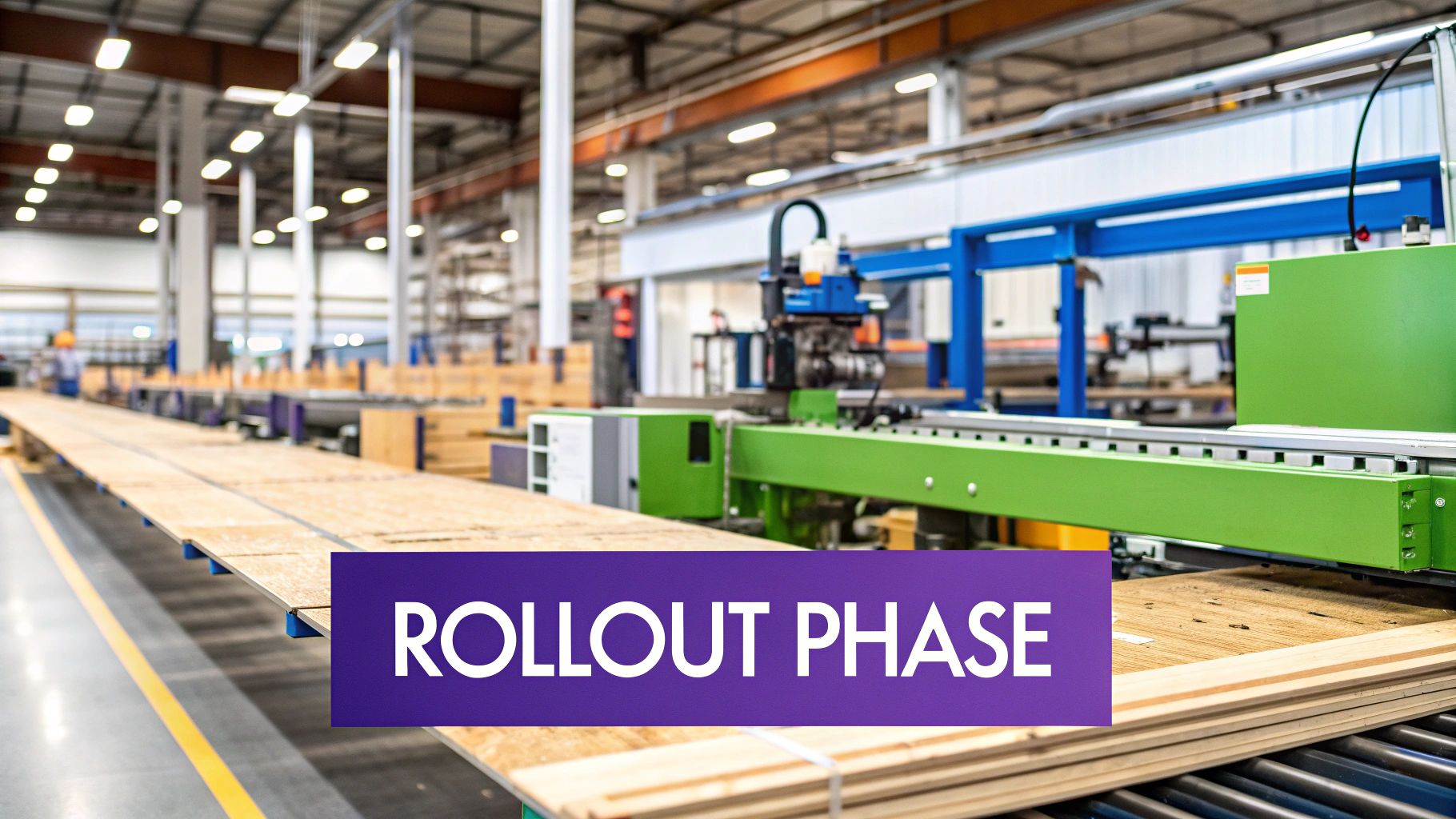
You’ve built something incredible. Now for the tough part: getting people to actually buy it. This final stretch, commercialization, is where so many brilliant ideas unfortunately fizzle out. It’s the make-or-break moment that turns a finished product into a real business.
And the challenge is no joke. Taking a successfully prototyped idea and scaling it for the market is often the hardest stage of all. A stunningly low 2–5% of all ideas ever reach full commercialization worldwide. While some places are great at turning research into products, many aren't, which shows a huge gap between creation and market success. You can dig into more of this data in the 2025 CTA Global Innovation Scorecard.
This is exactly why a solid go-to-market (GTM) strategy isn't just nice to have—it's absolutely essential.
Crafting Your Go-To-Market Strategy
Think of your GTM strategy as the playbook for how you’ll find, attract, and win over your customers. It’s all about answering a few key questions with total clarity. This isn't the time for guesswork. A well-thought-out plan is your best defense against a disappointing launch.
Start by nailing down these basics:
- Who is your ideal customer? Get specific. "Everyone" is not a target audience. Build a detailed picture of the person who desperately needs what you’ve made.
- What's your unique value? In a single, clear sentence, why should someone pick you over the competition? It has to be dead simple.
- How will you price it? Will you offer a subscription, a one-time purchase, or charge based on usage? Your price says a lot about your value, so be intentional.
- Which channels will you use? You can't be everywhere at once. Will you focus on content marketing, run paid ads, build a direct sales team, or work with partners?
If you need a step-by-step guide to make sure you've covered all your bases, our comprehensive product launch checklist is a great place to start.
A great product with a poor launch strategy is like a sports car with no fuel. It looks impressive, but it’s not going anywhere. The commercialization phase is where you fuel up for the journey ahead.
Launch, Learn, and Iterate
Your launch isn't the finish line. It's actually the start of a whole new feedback loop. The second your product is out in the world, your main job is to listen intently to how the market reacts. Keep a close eye on early customer comments, usage data, and sales figures.
This is a great time to bring a tool like Bulby back into the process. You can set up a new space just for collecting post-launch feedback. Get your customer support and sales teams in there, adding insights directly from their conversations. This turns random comments into a structured pipeline of ideas for your next update.
This cycle of continuous improvement is what separates a one-hit wonder from a lasting success. When you treat your launch as the beginning of a new learning phase, you set your innovation up to not just enter the market, but to truly thrive in it.
Common Questions About the Innovation Process
Running through the stages of innovation always brings up a few key questions, especially when you're trying to make it work with a team spread all over the map. Getting these things right can be the difference between a great process and one that just spins its wheels.
Let's tackle some of the most common hurdles I see leaders facing.
How Can We Get More Good Ideas From Our Remote Team?
This is a big one. When you can't just bump into someone in the breakroom, how do you spark that creative fire? The trick is to be deliberate about creating those moments.
You need a dedicated virtual space for ideas to live and breathe—think a specific Slack channel or a purpose-built platform like Bulby. This gives ideas a home so they don't vanish into the digital ether.
During your video calls, try adding some structure to your brainstorming. A simple round-robin, where every single person has to share one thought, works wonders. Most importantly, recognize and reward all contributions, not just the big winners. When people feel safe sharing half-baked ideas, you'll be amazed at what they come up with.
What Is the Biggest Mistake Companies Make?
Easy. They get so excited about a brilliant idea that they skip right past validation and testing. It's a classic case of falling in love with a concept and rushing it straight into development.
This is a massive gamble. You're operating on pure assumption, not evidence. Without putting a prototype in front of real users and getting honest, unfiltered feedback, you might be building something nobody actually wants. That dedicated testing phase isn't a "nice to have"; it's the step that saves you from wasting a ton of time and money.
A rigorous testing phase ensures the final product has a strong market fit, turning a good idea into a viable business solution. It’s the safety net that catches flawed assumptions before they become expensive failures.
How Do You Actually Measure the Success of an Innovation Process?
You have to look at more than just the bottom line. Success is a mix of hard numbers and softer, cultural shifts.
Of course, you'll want to track the concrete data. Things like:
- The raw number of ideas you generate each quarter.
- The percentage of ideas that make it past the first gate.
- How long it takes to get from idea to launch (your cycle time).
- The eventual ROI or new revenue from these innovations.
But don't stop there. Look at the qualitative stuff, too. Are more people getting involved? Is collaboration between departments getting better? A truly great process doesn't just pump out profitable products; it makes the whole company stronger and more creative. If you want to dig deeper here, check out our guide on how to measure innovation.
Ready to bring structure and energy to your team's creative process? Bulby provides AI-powered guidance and research-backed exercises to lead your remote team through brainstorming sessions that deliver real results. Transform your virtual collaboration by visiting https://www.bulby.com to learn more.

